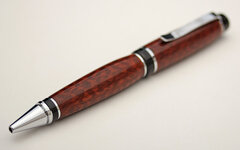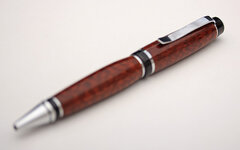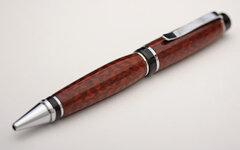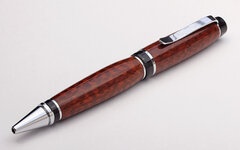Sylvanite
Member
Have you ever taken a picture of your latest pen, only to find that you can't get the whole thing in focus? You focus on the nib, centerband, or clip, but can't get all three sharp at the same time? If so, you've fallen victim to shallow "depth-of-field".
What is "depth-of-field" (DOF)?
Simply put, it is the distance between the closest point and the farthest point in a photo that are both in focus. The greater that distance is, the deeper the depth-of-field.
There is no single correct depth-of-field, but the traditional approach is to keep the photograph's subject in focus - and nothing else. That helps draws the viewer's attention where you want it. In landscape photography, one often wants very deep DOF, so the entire scene is in focus. In portrait photography, one often wants shallow DOF, so that only the subject's eyes are in perfect focus. For pen photographs, one typically wants the depth-of-field to encompass the entire pen - but not much more.
I've often seen people recommend you place the pen parallel to the camera body. That's an attempt to get the whole pen in focus within a shallow depth of field. Unfortunately, that means compromising your photo composition to match your camera settings. A better solution is to compose your photo for visual impact and set your camera controls for the desired depth of field.
Depth-of-Field is a function of three things:
In photographic terms, "sharpness" really means lens resolution. That is, does the lens produce a blurry image, or one with crisp details?. Some lenses are definitely better than others, but none are perfect. They all produce sharper results in the middle of the frame, and less sharp in the corners. They are sharper at moderate apertures (typically around f/8) than at minimum or maximum f-stop. Zoom lenses are generally sharpest at their midrange, and fall off at the extremes.
Don't let sharpness claims concern you too much though. The effects are minimal - especially if you are taking pictures to post in the internet. Almost all modern camera lenses have much greater resolution (sharpness) than needed for that.
In conclusion:
Compose your photo; place the camera at the location that yields the desired perspective; select a lens focal length to frame the shot; and set the aperture to give a DOF that encompasses the entire pen. Then choose an ISO setting and shutter speed for correct exposure.
Remember that depth-of-field increases with distance. That means depth-of-field will extend roughly twice as far beyond the point of focus than in front. Therefore, you should focus about 1/3 of the way back. Many cameras have a "DOF Preview" function that will allow you to check depth-of-field before taking the picture, or you can just shoot, view the result, and change the f/stop if necessary.
I hope that helps,
Eric
What is "depth-of-field" (DOF)?
Simply put, it is the distance between the closest point and the farthest point in a photo that are both in focus. The greater that distance is, the deeper the depth-of-field.
There is no single correct depth-of-field, but the traditional approach is to keep the photograph's subject in focus - and nothing else. That helps draws the viewer's attention where you want it. In landscape photography, one often wants very deep DOF, so the entire scene is in focus. In portrait photography, one often wants shallow DOF, so that only the subject's eyes are in perfect focus. For pen photographs, one typically wants the depth-of-field to encompass the entire pen - but not much more.
I've often seen people recommend you place the pen parallel to the camera body. That's an attempt to get the whole pen in focus within a shallow depth of field. Unfortunately, that means compromising your photo composition to match your camera settings. A better solution is to compose your photo for visual impact and set your camera controls for the desired depth of field.
Depth-of-Field is a function of three things:
- Distance. The farther away from the camera, the greater the DOF. You can't get very far away from a pen though, so increasing distance isn't very useful in pen photography.
- Focal length. The shorter the lens' focal length, the greater the DOF. Shorter focal lengths, however, also yield wider field-of-view. That means you have to get closer to frame your shot, which negates much of the depth-of-field advantage (as well as changing the photo perspective). Therefore, focal length isn't the right tool for controlling DOF in pen photography either.
- Aperture. The smaller the aperture (higher f/stop value), the greater the DOF. This is the correct way to control depth-of-field.
In photographic terms, "sharpness" really means lens resolution. That is, does the lens produce a blurry image, or one with crisp details?. Some lenses are definitely better than others, but none are perfect. They all produce sharper results in the middle of the frame, and less sharp in the corners. They are sharper at moderate apertures (typically around f/8) than at minimum or maximum f-stop. Zoom lenses are generally sharpest at their midrange, and fall off at the extremes.
Don't let sharpness claims concern you too much though. The effects are minimal - especially if you are taking pictures to post in the internet. Almost all modern camera lenses have much greater resolution (sharpness) than needed for that.
In conclusion:
Compose your photo; place the camera at the location that yields the desired perspective; select a lens focal length to frame the shot; and set the aperture to give a DOF that encompasses the entire pen. Then choose an ISO setting and shutter speed for correct exposure.
Remember that depth-of-field increases with distance. That means depth-of-field will extend roughly twice as far beyond the point of focus than in front. Therefore, you should focus about 1/3 of the way back. Many cameras have a "DOF Preview" function that will allow you to check depth-of-field before taking the picture, or you can just shoot, view the result, and change the f/stop if necessary.
I hope that helps,
Eric




